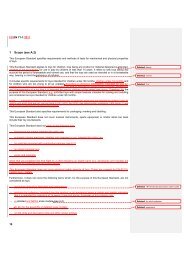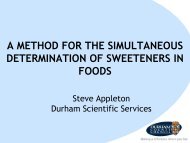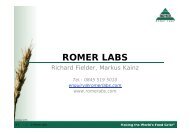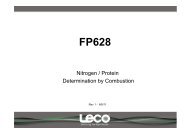Methodologies Basmati Rice & Bushmeat
Methodologies Basmati Rice & Bushmeat
Methodologies Basmati Rice & Bushmeat
You also want an ePaper? Increase the reach of your titles
YUMPU automatically turns print PDFs into web optimized ePapers that Google loves.
<strong>Methodologies</strong><br />
<strong>Basmati</strong> <strong>Rice</strong> &<br />
<strong>Bushmeat</strong><br />
DNA Seminar,<br />
Thursday 8 th May 2008
<strong>Basmati</strong> rice varieties<br />
• Saving on EU import duty of €65 per tonne for defined premium<br />
basmati varieties from India and Pakistan.<br />
• Premium price<br />
• <strong>Rice</strong> Association Code of Practice (July 2005) max limit for nonbasmati<br />
rice is 7% in products labelled as “basmati”.<br />
• In 2003 the main adulterants were Sherbati and Pak 386, detected in<br />
46% of products.<br />
• In 2006, adulteration with these two varieties had decreased to 16%
Intensity<br />
Existing authentication method<br />
• Based on the use of ‘microsatellite’ markers (= SSRs, STRs !)<br />
• Size of markers used to create a variety-specific profile<br />
• Area under the curve used to quantify levels of adulterant varieties<br />
Size
Agilent project<br />
• Aim to convert existing tests onto a single platform<br />
• Agilent 2100 BioAnalyzer<br />
• Difficulties in using microsatellite markers<br />
• Resolution >15 base pairs<br />
• Difficulties in measuring area under curve<br />
• Solution: alternative marker type required
Indel markers<br />
3’ 5’<br />
3’ 5’<br />
Size range of insertion/deletion is between 100 bp<br />
Generate large differences in fragment size<br />
Readily converted to PCR markers with 2 co-dominant alleles<br />
400,000 available in the rice genome database:<br />
• One INDEL every 1k bp<br />
• Flexible choice of fragment size based on primer design
Assay design<br />
• Examine the size of fragments<br />
across multiple varieties and<br />
multiple indels<br />
Taraori<br />
• Isolate indels that show<br />
categorical differences among<br />
varieties<br />
Sherbati<br />
• Select a panel of markers to<br />
produce a variety-specific<br />
profile<br />
Size
Size<br />
Example output<br />
1 2 3 4 5 6 7 8 9 10 11 12<br />
P 1 N N N P N 2 N N N P N P<br />
9<br />
8<br />
7<br />
6<br />
5<br />
4<br />
3<br />
2<br />
1
Variety results – ID rules<br />
• 596 (550-600) control (present in all)<br />
• 354 (330-358) all non-fragrant varieties<br />
• 273 (270-274) present in all approved <strong>Basmati</strong>s<br />
• 256 (254-260) *<br />
• 214 (213-218) present in all approved <strong>Basmati</strong>s<br />
• 186 (181-187) *<br />
• 174 (171-175) *<br />
• 142 (141-144) all approved except Pusa & Haryana<br />
• * if all 3 are present the sample contains a non-permitted<br />
variety
Band profiles<br />
<strong>Basmati</strong> Group 1 B1 B5 B4 B7<br />
Pusa <strong>Basmati</strong> (Group 2)<br />
Confirm with follow-on test I5<br />
<strong>Basmati</strong> 385 (Group 3)<br />
Confirm with follow-on test I10<br />
B2 B3 B4 B7<br />
B1 B3 B4 B7<br />
Kasturi (Group 4) B1 B5 B6 B7<br />
Haryana <strong>Basmati</strong> (Group 5) B2 B5 B6 B7<br />
Mahi Sugandha (Group 6) B1 B3 B6 B7<br />
Adulterant varieties<br />
Pak 386 B1 B3 B4 B8<br />
Sherbati 1 B2 & B1 B3 B4 B8<br />
Sherbati 2 B2 B3 B6 B8<br />
Supra B1 B3 B6 B7 & B8<br />
Superfine B2 B3 B6 B7 & B8<br />
Mugad Sugandha B2 B3 B6 B7 & B8<br />
Pusa Sugandha B2 B3 B6 B7
Variety SOP<br />
FOOD STANDARDS AGENCY<br />
STANDARD OPERATING PROCEDURE (SOP) 3<br />
Version 1.0, October, 2007<br />
STANDARD OPERATING PROCEDURE FOR THE DETECTION OF<br />
NON-PERMITTED RICE VARIETIES BY INDEL-PCR ANALYSIS<br />
USING THE AGILENT 2100 BIONALYZER<br />
• Available for use in-house<br />
• Available as a service from Tepnel and other genetic analysis providers
Quantitative test<br />
• Original test uses area under curve<br />
• Preferred DNA quantification of mixtures<br />
is via Real-Time PCR<br />
• Agilent method restricted to analysis of<br />
electrophoresis peaks<br />
• Decision to be made regarding baseline /<br />
threshold for measurement<br />
• Has implications for quantitative analysis
Quantitative SOP<br />
FOOD STANDARDS AGENCY<br />
STANDARD OPERATING PROCEDURE (SOP) 1<br />
Version 1.0, August, 2007<br />
STANDARD OPERATING PROCEDURE FOR THE QUANTITATIVE<br />
ANALYSIS OF ADULTERATION OF BASMATI RICE WITH THE<br />
VARIETIES SHERBATI, MUGAD SUGANDHA, PAK 386 OR SUPERFINE<br />
USING THE AGILENT 2100 BIONALYZER AND A MICROSATELLITE<br />
PCR MARKER<br />
• Recommended as an initial screen for adulteration above 7%<br />
• Quantification with these methods is complicated, assumptions<br />
need to be understood<br />
• For legal enforcement, the original test should be used.
<strong>Bushmeat</strong> Identification<br />
• Surveys at Heathrow and London markets reveal bushmeat<br />
importation<br />
• Issues: Zoonoses, livestock disease, meat hygiene, conservation<br />
Southwark market.<br />
Smoked antelope meat.<br />
Smoked cane rat.
Species identification<br />
• Species identification of truly unknown samples<br />
requires DNA sequencing<br />
• Sequencing is not possible at most PA labs<br />
• Species detection tests easier to perform<br />
• Test exist for many common species exist<br />
• Aim to develop a test covering a range of illegally<br />
imported African wild species:<br />
• Chimpanzee, Gorilla, Mandrill<br />
• Duiker, Bushbuck, Porcupine<br />
• Cane rat, Grass cutter, Pouched rat<br />
• Bush pig, Zebu, African sheep
Methodology<br />
Restriction Fragment Length Polymorphism (RFLP)<br />
• Amplify common fragment by PCR (mitochondrial cytochrome b gene)<br />
• Digest with two restriction enzymes<br />
• Generate fragment profile to match against references<br />
HinfI<br />
MseI<br />
Species A<br />
Species B<br />
Species C
Chimpanzee<br />
Chimpanzee<br />
Gorilla<br />
Gorilla<br />
Bushbuck<br />
Bushbuck<br />
African sheep<br />
African sheep<br />
Dwarf zebu<br />
Dwarf zebu<br />
Zebu<br />
Zebu<br />
Example results<br />
• Agilent output: fragments (bands) following HinfI restriction<br />
• Different species show<br />
different numbers and<br />
size of fragment<br />
• Where a pattern is<br />
shared between species,<br />
different enzymes may<br />
be used
Example results<br />
• Fragment categories define profiles<br />
Species<br />
HinfI<br />
MseI<br />
Chimp C E K D E L<br />
Gorilla G M H L<br />
Bush buck E G K I L<br />
Sheep E N E F K<br />
Dwarf zebu B E K J K<br />
Zebu B E L J K<br />
Duiker 1 C E K D G K<br />
Duiker 2 C E K E M<br />
Bush Pig D E K C E L<br />
Pouched Rat E N D E L<br />
Fragment size Category Fragment size Category<br />
1 to 20 A 155 to 180 H<br />
25 to 40 B 185 to 200 I<br />
45 to 60 C 205 to 225 J<br />
65 to 90 D 230 to 260 K<br />
95 to 105 E 325 to 345 L<br />
110 to 125 F 350 to 370 M<br />
Cane 130 to Rat 150 E M G 375 to 400D F G NH K<br />
Porcupine C E F K D E G H
Applications<br />
• Best to use following negative results from common species<br />
identification tests<br />
• Care needs to be taken to ensure complete digestion<br />
• Care needs to be taken when ‘binning’ bands (size variation)<br />
• SOP available from FSA:<br />
FOOD STANDARDS AGENCY<br />
STANDARD OPERATING PROCEDURE (SOP) 1<br />
Version 1.3, November, 2007<br />
STANDARD OPERATING PROCEDURE FOR THE GENETIC<br />
IDENTIFICATION OF COMMON AFRICAN WILDMEAT SPECIES<br />
USING THE AGILENT 2100 BIOANALYZER
Acknowledgements<br />
Katherine Steele, Ross McEwing, John Gorham<br />
(Food DNA Services)<br />
Jacqui Coutts<br />
(Tepnel)<br />
rogden@tepnelscientific.com








